Last Updated on August 1, 2024
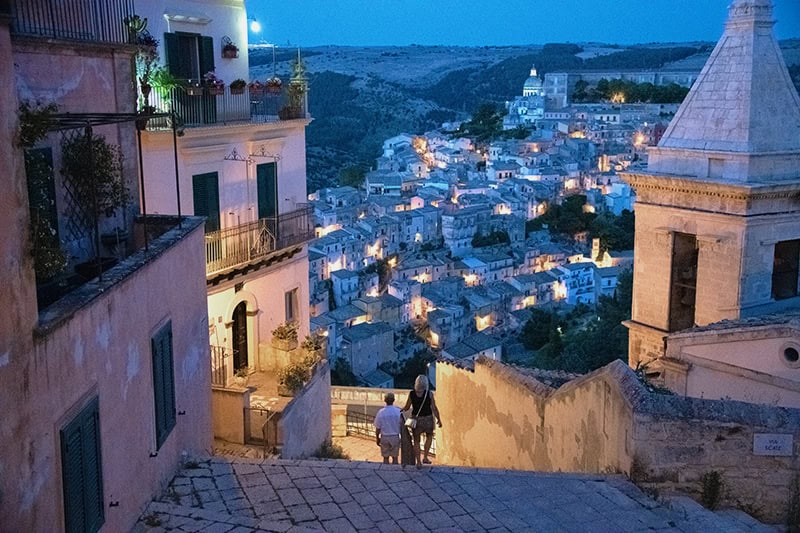
This was a great trip…a bit fast, but still a wonderful experience. Try to see Mt. Etna from the inside…
Estimated reading time: 21 minutes
By Jim Ferri
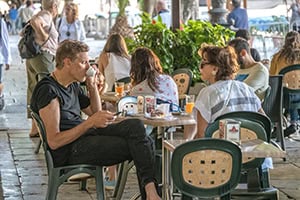
My first visit to Sicily was several decades ago when I was a freelance photographer visiting Rome. One day on a whim, I decided to take the train to Palermo, a 12-hour trip. It was a fascinating few days, followed by a second visit years later.
Fascinated by the island, I returned a third time not long ago. This time, however, I was determined to see a broader swath of the island, to better understand why it has become one of the top places to visit in Italy.
One of the obvious reasons is its mystique that’s not found on mainland Italy. That mystique is so unique people don’t even identify themselves as Italian but as Sicilian. A visit to this island is a journey through the ages since Sicily was conquered by the Greeks, Romans, Byzantines, Arabs, Normans, and Spanish at one time or another. Each left a cultural legacy that is still seen today.
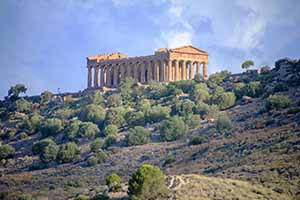
The east and south, for example, are decidedly Greek. Incredibly, Sicily has the most ancient Greek temples in the world, even more than Athens.
The western half of the enormous island is a mash-up of Arab and Norman architecture, readily seen in its dazzling architecture. In south-central Sicily, the Romans left their footprints in a villa that’s home to the most exceptional Roman mosaics in the world.
East, west, north, and south, Sicily is still relatively unknown to travelers and begs you to explore. The best way to see it is by car.
Be aware, however, that you could spend a lot of time behind the wheel here if you enjoy long road trips. Sicily is the largest island in the Mediterranean, about 10,000 square miles / 2,500 square kilometers in size.
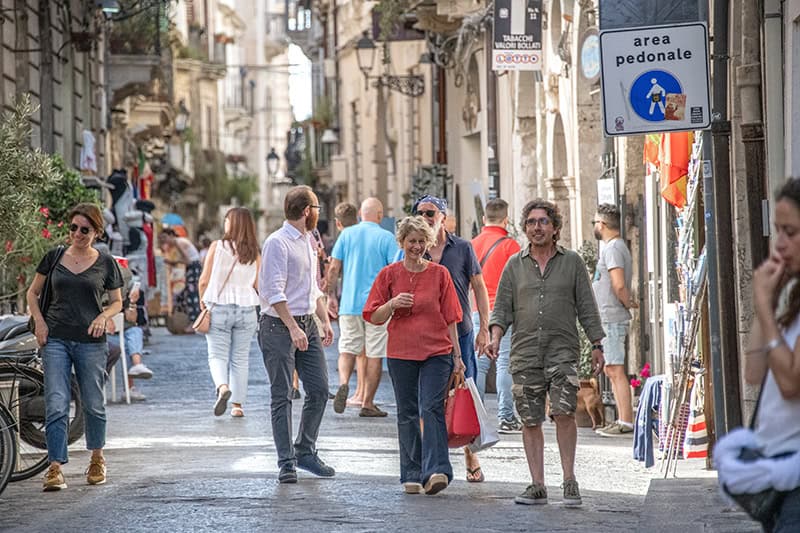
Planning / Budgeting a Tour of Sicily By Car
The total cost of my car (an economy from Avis in Catania, prepaid in the U.S.) was $223. Gas was an additional $143.
Hotel costs for eight nights totaled $1,120. I selected only hotels with free wi-fi, complimentary breakfast, and a parking area. All were booked online (non-refundable to get the lowest price) before leaving the U.S. You’ll find their names, addresses, and comments in each section below.
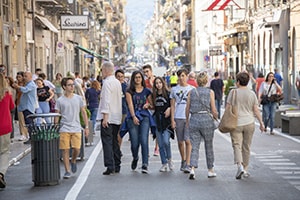
Many guidebooks suggest a week-long tour of Sicily, carving out a section or two of the island to explore deeply. But I wanted to see more of Sicily by car and complete the trip in about the same time.
I completed my tour of Sicily – driving approximately 900 miles around the island in nine days and eight nights. There were early mornings, of course, and, at times, long stretches between stops. But since the main roads are well maintained, you can move about fairly quickly.
When driving in Sicily, you will need a GPS, either built into the rental or a portable one brought from home. You can also use your cell phone and Google Maps as a backup.
An 8-Day Driving Tour of Sicily
This map depicts a tour of Sicily by car, including the main places mentioned in this article. Press +/- to enlarge it or make it smaller. It can also be viewed, and the route followed, on your smartphone.
When Seeing Sicily By Car, Rent and Return At the Same Airport
Eastern Sicily has two airports, Fontanarossa in Catania and Falcone Borsellino in Palermo, the two largest cities in Sicily. Some guides suggest renting a car in one city and leaving it in another.
But when seeing Sicily by car, renting a car in Catania is better. Then, make a complete circuit of the island and return it to Catania. Then you’ll not miss some must-sees, and you’ll save on the rental since you’ll be returning it to where you rented it. And you’ll also know where to return your vehicle, which can be a nightmare in some Italian airports.
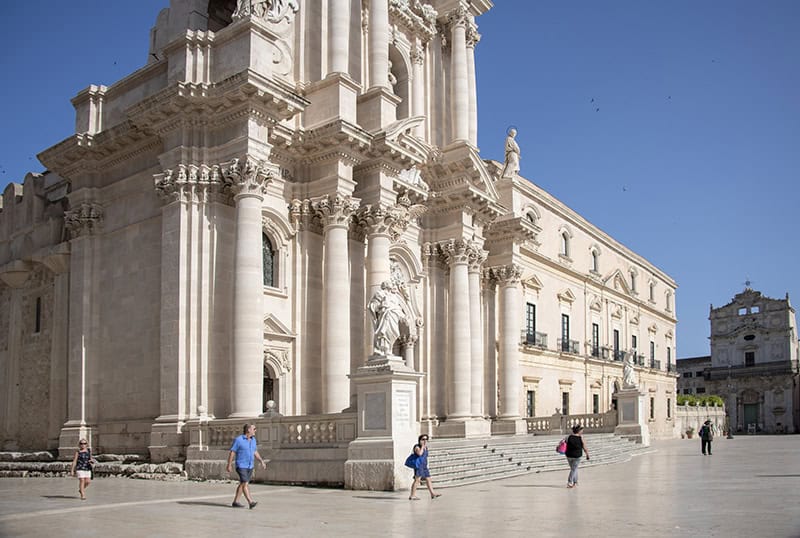
Skip Catania and Make Syracuse Your First City in Sicily
Since your time will be tight when seeing Sicily by car, skip Catania altogether. It’s an industrial city with little to see. It’s best to concentrate on more fertile areas during a driving tour of Sicily.
After renting my car at the airport in Catania, I made the hour drive to Syracuse, which, along with Catania and Messina, was the center of Magna Graecia. You’ll find a lot of Grecian history in Sicily, which, architecturally speaking is more Greek than Greece.
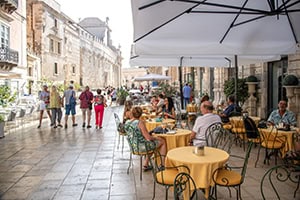
Home to Plato, Pythagoras, and Archimedes, Syracuse was once the most powerful city in the Mediterranean. You see vestiges of its heritage in the Greek and Roman Theaters and in the Museo Archeologico Regionale, which holds the mother load of items found in archaeological digs in the area, 18,000 pieces in all.
If you’re short on time, stick to the area of Ortygia, the island connected to the city by a small bridge. Wander its streets and alleyways and don’t miss the Piazza del Duomo. Visit the church, which encompasses a 5th-century BC temple to Athena behind its Doric columns, one of the most spectacular in Sicily. The piazza is also a good place to stop for a drink at the cafe across from the Duomo.
My hotel was the Grande Albergo Alfeo, Via Nino Bixio 5 Syracuse. Just a few blocks walk to Ortygia, but street parking was a problem. Cost $147.17 per night.
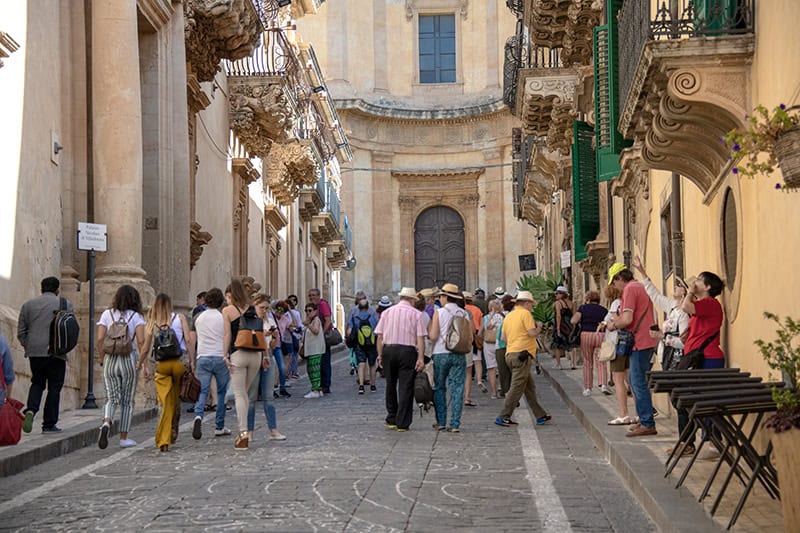
Baroque Sicily By Car
The following morning, I set out early for Noto, the central city in the Valley of Noto, further south.
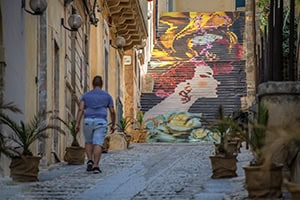
Mostly, I found Noto only moderately interesting, nothing near what I expected after all the guidebook raves about it being the most Baroque city in Italy. I discovered its small-ish Old Town did have Baroque character, but it was nothing like Lecce in Puglia, where the Baroque old town is quite expansive.
It was mid-morning and already quite hot when I headed for the Duomo, which opened at 10 am (it’s open only from 10 to 12 and 4 to 6:30 pm).
The Cathedral was worth the wait and the climb up its three flights of stairs to see the beautiful frescos inside. Although women are forbidden entry if they have bare shoulders or are wearing shorts, you’re given a shawl to drape around yourself. There’s no entry fee, although a little basket for offerings is at the door when you exit.
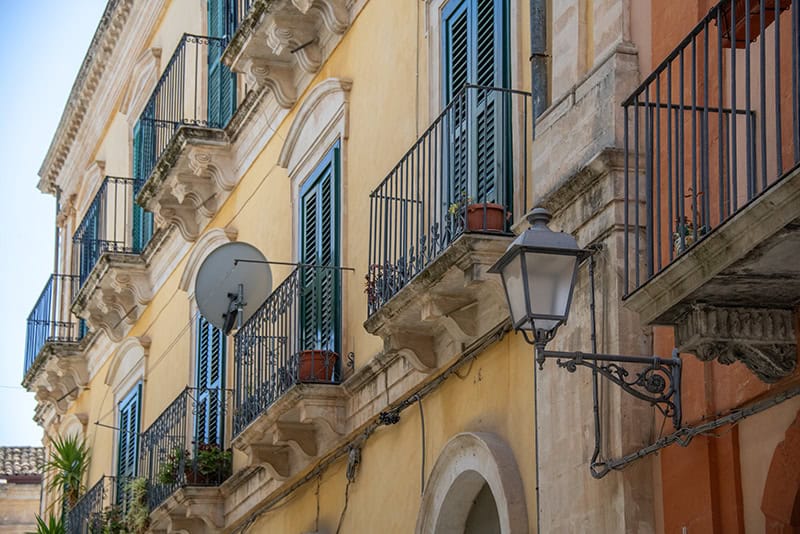
Ragusa, A Beautiful City In Sicily
I was soon off to Ragusa, which, along with Modica, is part of the Noto Valley. During the one-hour drive, I was captivated by the countryside flecked with olive groves and vineyards, with stonewalls running across hillsides in every direction. It was June, and there were flowers everywhere you looked. Although the countryside was rugged, everything seemed orderly, as if painted on canvas.
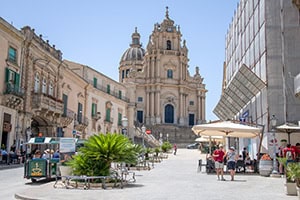
I loved Ragusa, a UNESCO World Heritage Site split into two distinct cities. Following a devastating 17th-century earthquake, some inhabitants decided to build a new town in Baroque style on the plateau above the old. Others chose to stay put and rebuild the old town, now called Ragusa Ibla, the atmospheric city in the valley below. It’s a beautiful place to walk and climb around for an afternoon. Whether you’re seeing Sicily by car or tour bus, it’s a must-stop.
My hotel was the Villa Boscarino (Via L.A. Muratori, 63 Ragusa), a modern hotel built inside a small historic building. You’d likely never find it without GPS (but you shouldn’t be driving around Sicily without GPS anyway) since it’s outside the typical tourist area of the “new” city. On the other hand, it’s only 10 minutes from Ragusa Ibla. It was comfortable with a good staff, although breakfast was sparse. Cost: $96.44 per night.
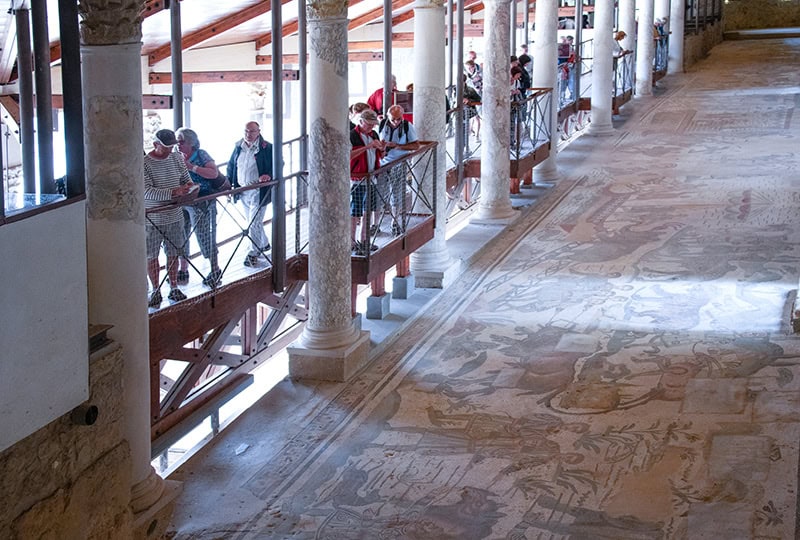
Piazza Armerina
Soon after leaving Ragusa on the two-hour drive to Piazza Armerina, I was in Sicilian wine country. The numerous vineyards, their vines covered with netting as protection from birds, gave the area the look of a giant checkerboard.
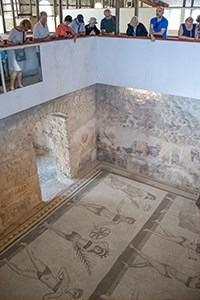
Turning further inland to Piazza Armerina, I was surprised to find that many cutouts on the road were littered with garbage. I had yet to see this elsewhere (in fact, this was the only area in Sicily where I found this).
The drivers also seemed more aggressive, riding close behind, awaiting the opportunity to pass. The torrid summer sun has baked many old road signs beyond recognition. (No one, it seems, removes and replaces them—they merely plant a new sign further down the road.)
While driving in Sicily, on secondary roads, you often come across large tractors crawling along the roadway. They remind you that you’re in serious farm and wine country. All about you, little abandoned stone homes seem to be everywhere, while every so often, a little village pops up out of nowhere on the monochromatic hillside.
I was not staying in Piazza Armerina; I was only making a detour en route to Agrigento to see the famous Villa Romana del Casale, the hunting lodge of an important Roman, now a UNESCO Heritage site. It has the world’s most extensive and best-preserved Roman mosaics, including the famous “bikini girls.” It was worth the detour.
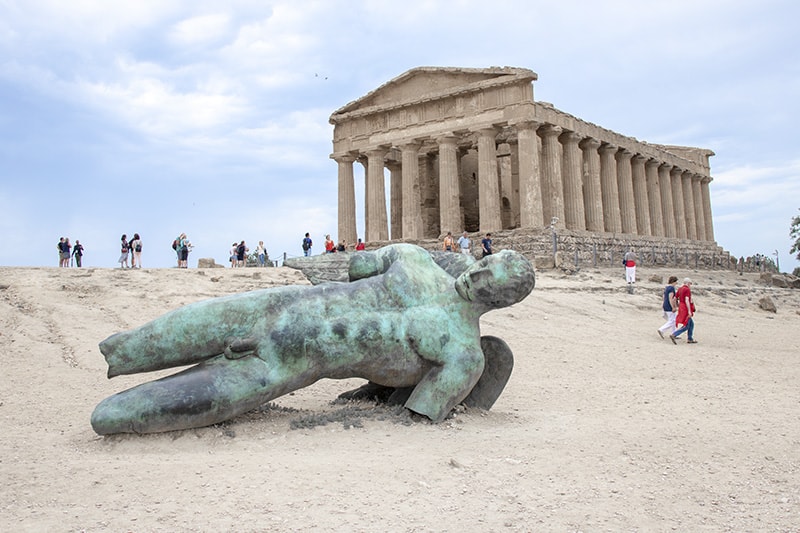
Agrigento and the Valley of the Temples
Include Agrigento on any driving tour of Sicily. Visit it, and you will quickly understand why. It’s a 1½-hour drive southwest of Villa Romana del Casale in Piazza Armerina.
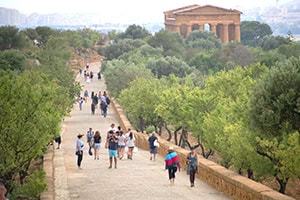
At one time, it was a town of 200,000; Agrigento’s crown jewel is a valley containing the spectacular ruins of five Greek temples, which in their day rivaled those of Athens. Park your car and take the three-mile walk along the main avenue. There’s also a small shuttle tram.
It’s a beautiful and interesting site that contrasts significantly with the view of the unappealing modern city in the distance.
My hotel was B&B Via Dei Templi, Via Panoramica Della Valle Dei Templi 5 Agrigento. It’s in a small apartment as you enter the town, so you don’t get caught up in city traffic. Next door is a good restaurant, the Trattoria Dei Templi. The rate for the B&B was $76.92.
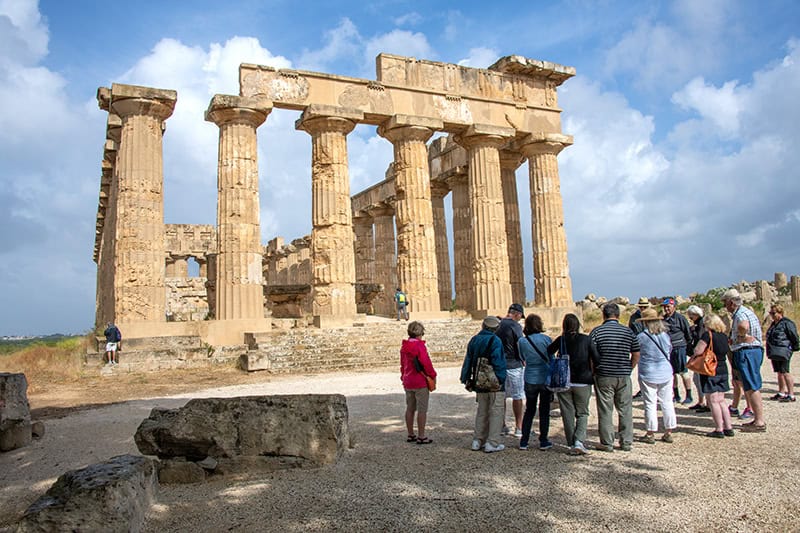
Selinunte
I set out early from Agrigento on the longest leg of my driving tour of Sicily, a six-hour, 200-mile drive to Palermo, with stops along the way. It wasn’t as daunting as it might seem; it was an enjoyable and exciting day.
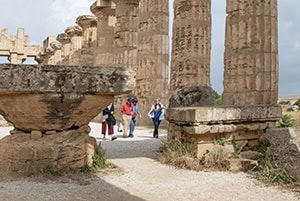
My first stop was in Selinunte, a 1½-hour drive westward. Once the most westerly settlement of Magna Graecia, it was settled about 600 BC but was later destroyed by the Carthaginians. What remains today are the ruins of five temples and an acropolis.
One of the temples, the Temple of Hera, has been reconstructed from the ruins. Although the remainder of the site appears to be a jumble of ruins, Selinunte is actually one of the most important archaeological sites in Europe.
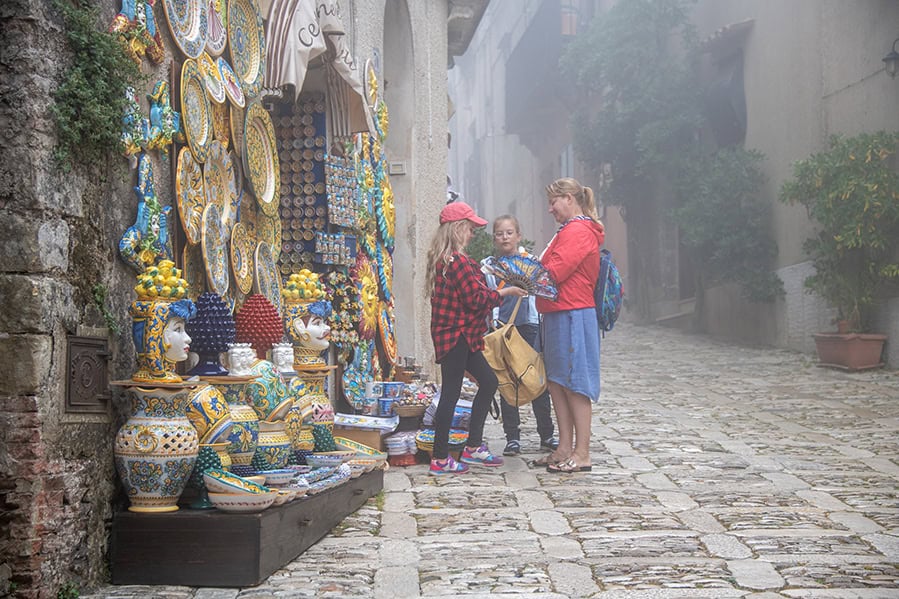
The Salt Pans and Erice
I took the coastal road to Trapani, another 1½-hour drive, because I wanted to see the salt pans that dot the salt marshes near the town of Nubia. I expected to be one of the few there, but when I arrived, I found several dozen people as inquisitive as me.
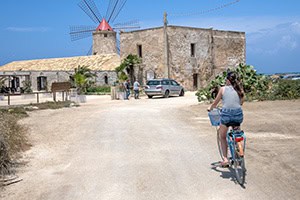
It is still a working area harvesting salt from the sea. It’s peppered with windmills used to pump water in and out of the saltpans, and there’s also a small museum worth the €3 entrance fee.
I spent about an hour there and another half-hour driving to Erice, a little medieval village with its head in the clouds – literally.
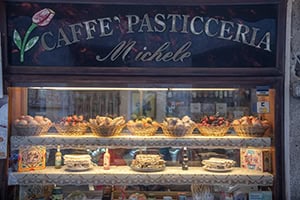
Erice sits on a mountaintop above Trapani. You reach it via cable car (€9 round trip / €4 under 16) or a severely winding road going up the steep mountain. I chose the latter and found a crowded parking lot outside the city gate. I also found a village entirely enveloped in fog, with a temperature 14° lower than at sea level.
Erice survives on tourism and a fledgling wine industry. Walking along its medieval stone streets felt ethereal in the fog. I stopped in the popular Michelle’s Caffe + Pasticceria for some treats and a cup of cappuccino before heading back to my car. I would never have seen the saltpans and Erice if I hadn’t seen Sicily by car, which provided great flexibility.
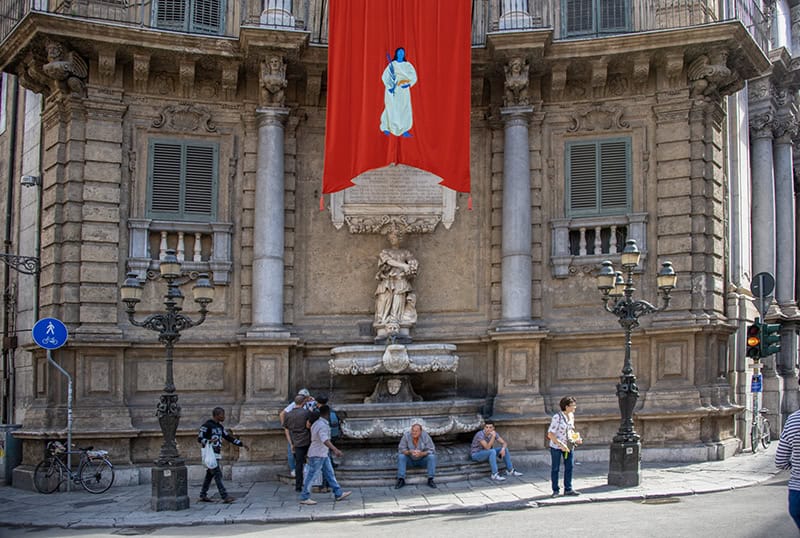
Palermo: Chaos, Culture, and Charm
My target that afternoon was Palermo, the capital, most significant, and best-known city in Sicily. It was about a 2½ –hour drive, not counting the time I spent en route at Segesta, often described as the best-preserved Greek temple in the world. Right off the Autostrade, Segesta is relatively easy to get to. Seeing it was another benefit of doing a self-drive tour of Sicily.
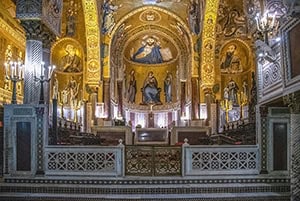
Raucous Palermo was the diametric opposite of serene Segesta. As soon as you enter the city, you’re met with a torrent of traffic rarely experienced elsewhere.
Despite its traffic woes, Palermo is a fabulous city with much to offer. The Normans and Arabs have left great cultural and artistic legacies throughout the town. Don’t miss the Arab-Norman art in the Cappella Palatina, the Cathedral, the Norman Palace, Ballarò Market in the Albergheria Quarter, and Quattro Canti at the intersection of Corso Vittorio Emanuele and Via Maqueda.
The incredible Cathedral at Monreale, a half-hour from the central city, epitomizes Norman-Arab art and architecture. It is one of the most spectacular places you’ll see in Italy. And there’s plenty more, too much, to list here.
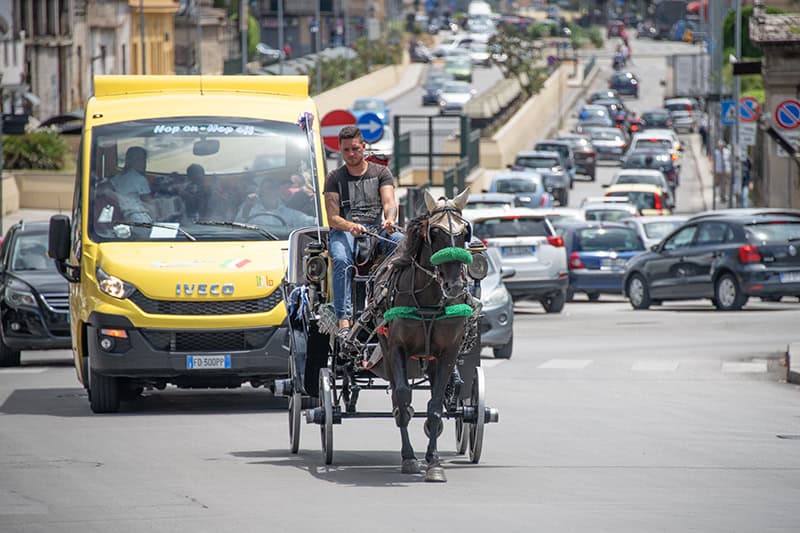
Dealing With Palermo’s Car Problem
I had been warned not to drive in Palermo while seeing Sicily by car, which was valid advice. In addition to the incredible traffic, street signs are lacking, and GPS within the city is often useless. On one occasion, I mistakenly drove through the city’s busy Ballarò Market, where the crowded walkways were only inches wider than my car. One solution is to find parking garages in Palermo.
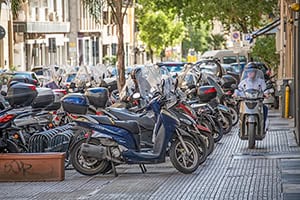
But I needed my car in Palermo to continue in two days and reach sites outside the city. My solution was to find a hotel where I could leave my car most of the time and then depart the city early on Sunday morning when traffic was light. The strategy worked quite well.
I had initially booked a room at the Hotel Garibaldi, but they had overbooked me when I arrived. They moved me to the Hotel Vecchio Borgo, a few blocks away at Via Quintino Sella, 1. My room was comfortable, but I had to pay €18 per day for parking in front of the hotel. The hotel cost $403.24 for two nights (excluding parking).
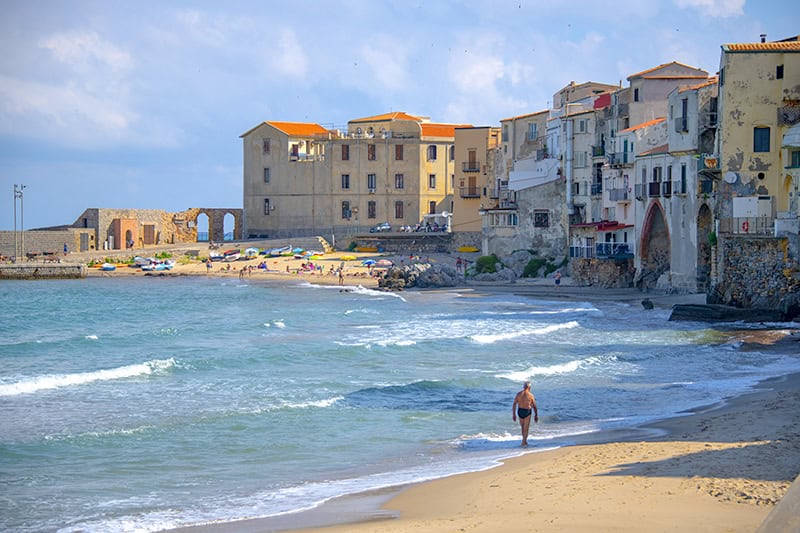
Charming Cefalù
After leaving the chaos of Palermo, arriving in Cefalù was like a dream. Calm, green, clean, and quiet, it’s more like the French Riviera than the rest of Sicily.
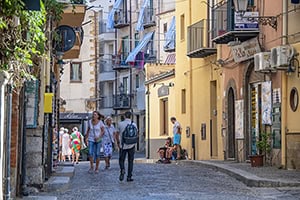
The beaches along the cobalt-blue sea along the north coast of Sicily are beautiful and much cleaner than elsewhere. The beach attracts many to popular Cefalù, although the village retains its medieval character.
In addition to its beach, Cefalù is renowned for the Byzantine mosaics in its Norman cathedral, which was built by Norman King Roger II after he landed at the village after a tumultuous sea crossing.
I would have liked to stay in Cefalù longer, even another day, but I needed to drive to Taormina and Mt. Etna, a three-hour drive across the interior.
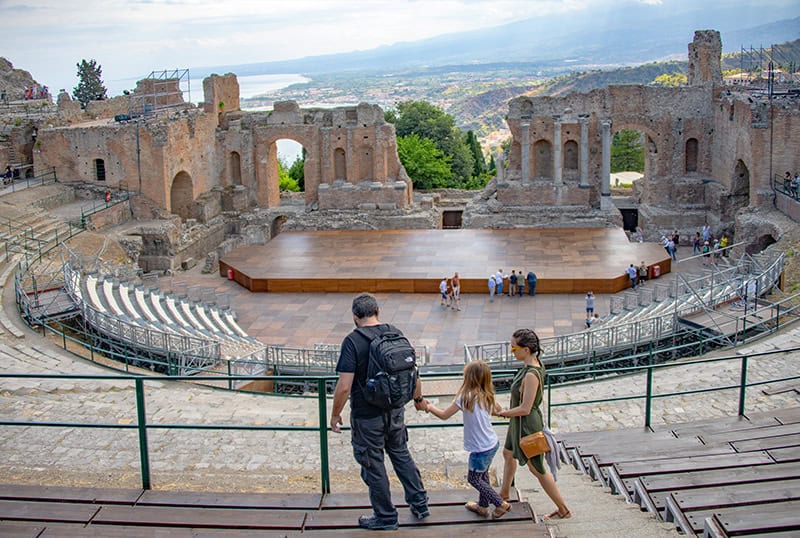
Taormina, a Requisite Stop on the Grand Tour
My driving tour of Sicily put me on the Autostrade across central Sicily, from Cefalu to Catania. It took me through valleys below craggy mountains and soft rolling hills covered with olive trees and grazing cows. From Catania, it was an easy one-hour drive north to Taormina.
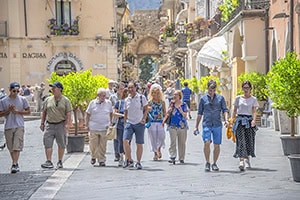
Once a colony of Syracuse, Taormina remains the most popular holiday destination in Sicily. Its popularity dates back to the 19th century when it was a requisite stop on the Grand Tour of Europe. This was most likely due to its mountaintop location with superb views of the sea, coastline, and Mt. Etna. It’s still a very charming place.
Little alleyways climb up and down the hills on both sides along the Corso Umberto, the main street of Taormina. You see nothing but shops, restaurants, gelaterias, and cafés everywhere you turn. Midway, at Piazza IX Aprile, the view of the sea and the coast is spectacular. Just as dramatic is the view of, and from, the 3rd-century BC Greek Theater.
I stayed two nights at the Hotel Condor at Via Dietro Cappuccini 25 in Taormina. The cost was $68.73 per night. The room was simple but comfortable, and the breakfast was good. However, there was an added fee for parking in a secure nearby lot, which you must pay in cash.
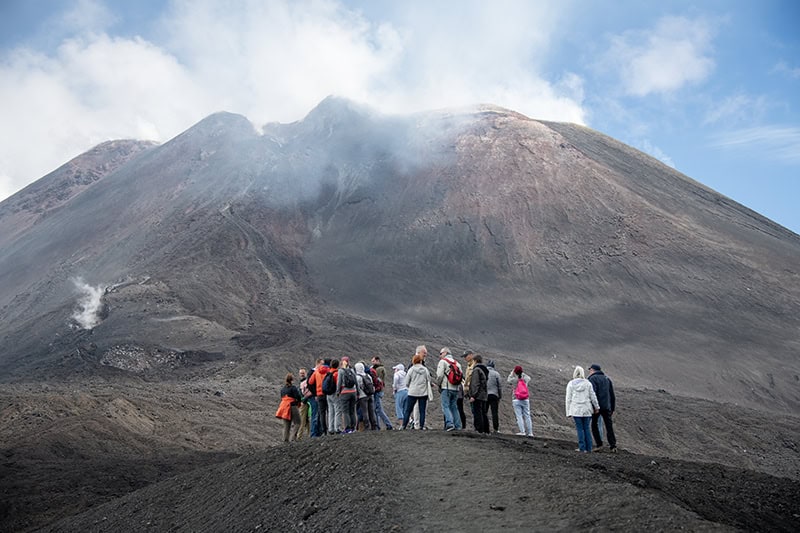
Mt. Etna, the Highlight of My Tour of Sicily
Few volcanoes on earth are as well-known as Sicily’s Mt. Etna, Europe’s largest active volcano.
It’s a massive mountain so large it generates its own weather patterns. That can be problematic since the weather at the top can change quickly, resulting in canceled tours. Nevertheless, I had made up my mind I was going to see it up close near the top. It turned out to be the highlight of my driving tour of Sicily.
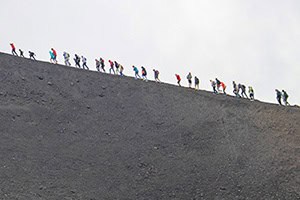
I had gotten directions from my hotel on how to reach Rifugio Sapienza, which is at 5,900 feet. From Sapienza, you take a six-person cable car higher up the mountain.
It was a fantastic place and a unique experience unlike anything else I had ever done anywhere in Europe. Also, it was a bit cool — 2°C (35°F) on a hot June day — ensuring a brisk business for jacket rentals for €4 each.
The best time to visit it is in the early morning. If you see Sicily by car, that’s easy to do, but it’s difficult on a tour. By late morning, clouds drift in, increasing the possibility of inclement weather. Going early also ensures you’ll find available parking. Park on the roadway, and you can be ticketed.
After my tour of Etna, I drove to Syracuse to stay overnight before my morning flight from Catania to Rome. I chose the Hotel Posta at Via Trieste 33 (rate: $95.12), which has parking in an adjacent lot. Breakfast was good, although, for dinner, I visited one of the outdoor cafes around the corner.
You may also enjoy: A Guide to Sampling Wines and Wineries in Sicily / Best Places to Visit in Europe – 9 Worth a Detour / Best Places in Italy (You Likely Don’t Know)
If You Go:
Italian National Tourist Board
http://www.italia.it/en/home.html
New York
686 Park Avenue – 3rd Floor
New York, NY 10065
n[email protected]
Los Angeles
10850 Wilshire Blvd. SUITE 575
Los Angeles, CA 90024
[email protected]
Toronto
365 Bay Street – Suite 503
Toronto (Ontario) M5H 2V1
[email protected]

Traveling to Sicily in Oct. This was a great read and good info. Since we are on our own instead of a tour, planning our 10 day itinerary is challenging considering everything to see on our be Island! Thanks for the advice!
I’m glad is was helpful Barbara. If I can help with any other info, let me know.
Hi thanks for the info. If we choose to stay only in the east and center of the island where (which cities) would you suggest to stay? Thanks
Hi Lili,
Syracuse / Siracusa is nice – especially the old section – and that would give you access to everything along the east coast, as well. It’s a half-hour or so from Catania airport, and 1 1/2 hour drive to Taromina in the north or Ragusa to the south. In the center of the island I’d suggest Agrigento because of its group of Greek temples. From there Piazza Armerina with its Villa Romana del Casale is a 1 1/2 hour drive. If you’re not planning on renting a car, you’ll find organized day tours from many cities also. Does this answer your question? If not, please let me know. I hope you have a wonderful trip!
Hi really enjoyed this article thank you. We are flying to Palermo and hoping to stay somewhere close by, near to the beach. Where would you reccomend please? Also hoping for some sunshine! ? cheers
Hello Sharon,
I just saw that I never answered your question. I apologize. Have you already taken the trip?
how was the actual drive? Were there certain areas you found more challenging besides the capital? Were the hill towns difficult? I’m planning on doing this a single woman, expect going to avoid the capital.
Thanks!
Hi Shawna,I really enjoyed this trip. I covered a LOT of ground because I was driving quite fast at times. You can cover just about everything I did if you skip Palermo, which I’d recommend a single woman do. But I would still try to visit Monreale, if you can, since it is beautiful.
Noto and Ragusa were easy to get to from Siracusa since there’s a good highway connecting them. My drive to Piazza Armerina took me across some wide swaths of farmland and when I finally reached the town I had trouble locating the road to the Villa Romana del Casale. I was fine, however, after I finally asked someone for directions.From there to Agrigento was an easy drive.
The drive from Agrigento to Erice was long and tiring. If you’re going to skip Palermo, you can head striaght to Cefalù. I wish I was able to spend an overnight there but it don’t work right with my plan to get to Taormina, which I enjoyed. If you’re staying in Taormina (the most interneational of all the Sicilian cities) the drive up into the town can be a bit daunting since in town you’re on a winding and narrow road which is going uphill. If you stay here make certain your hotel (or whatever) has a place for you to park. Mine did, but it was in a secure lot down the street, which was fine with me. Also, they never told me that I had to pay for the parking in cash until I was checking out (I didn’t have the cash and balked about it and they finally put it on a credit card). If you’re going to Mt. Etna get very specific directions and a map. It’s really worth the drive, however, and it was one of the highlights of my trip. I hope that’s helpful – if you have other questions, let me know. I’ll be glad to answer them.
Jim
Enjoyed your trip’s description. I am planning to visit there in October with my kid. I will hire car in the airport and stay 4 days in Sicily. I will visit Etna and other UNESCO Heritage sites. But do not know if I will be able to cover all. Do you have any suggestion about travelling acrosss Suicily with kid? Thanks in advance.
Hi Sazzadur,
You won’t be able to see a lot of Sicily kn 4 days since the island is so big (it’s the largest in the Mediterranean. If I were you I’d only visit the east coast, where there is a lot to do and see. How old is your kid?
Jim
Sounds exactly like the type of vacation we would love. I have no problem driving but I hesitate to drive in Palermo. Is parking outside of the city and leaving the car for 2 days in secured parking a viable option? We love the outdoor markets and in my research it appears Palermo’s markets are great!! I Was thinking that maybe we could use your itinerary starting in Palermo instead of Catania? We are planning 10 days. Do you feel your tour was rushed?
Hi Stan,
Up until I arrived in Palermo, my tour was rushed because of the distances. And 10 days would be less rushed than my 8 days, so that would be a bit easier. I think it’s a great idea to start in Palermo, since then you don’t have to worry about parking the car.
Jim
Hello, I enjoyed your article and learned something too. I like the idea of driving – its faster than the trains and I can’t do buses but once I drive to my hotel (3 friends and I are planning to go for 12 days) , I don’t really want to then have to drive to each ‘sight’. Do the hotels have various guided tours to the sights in the area? If I don’t reserve anything I don’t want to get stuck being unable to see the various sights. Thank you!
Hi Stacey,
You’ll find that in some cities like Agrigento, Ragusa and Palermo the sites are either in the city or are quite near it. You can easily visit them by taxi. Others, such as Selinunte, Erice and Cefalù are further out and you can pay them a quick visit for a couple of hours en route to another city. In my opinion, a good thing to do is to have the hotel in which you’ll be staying make arrangements for a tour guide who can show you around while you’re in each city. Still another idea – since there is only 4 of you – is to have guide/driver with a comfortable van drive you around Sicily on your trip. That way you’ll be able to see a lot more, and a lot faster, than you would on your own. You would also save on the cost of a car rental and you won’t have to find a guide in a dozen or so different places. You’ll have your own expert (whose references you’ll be able to check in advance) to show you the best of Sicily. And overall, I think this will also be the least expensive way.
I hope this is helpful and that you have a wonderful trip.
Jim
Your article is very informative and helpful. How would you find a guide/driver to drive around a small group in some of the cities you mention? I would like to have that arranged before checking into a hotel. Thank you.
Hi Linda,
I would contact the tourist office of each city and ask them for recommendations. By doing that you’re usually assured of getting a good reliable guide. If you have an insurmountable problem doing this, please leave another comment here.
Jim
Thank you so much. I will give that a try.
What is the best car size to rent in Sicily?? Thanks for the advice
We are thinking of travelling to Sicily in late June. Is it easy to drive between cities there? Are there motorways – thanks
Hi Paula,
It’s easy to drive between different cities in Sicily. The highways are well maintained and sign-posted. You’ll likely get more traffic in late July, however, since that’s already into the high summer season. Driving your own rental, you’ll love the opportunities to get off the main road and wander a bit more. Just be aware of the parking situation and chaotic traffic in Palermo if you venture that far.
Have a great trip!
Jim